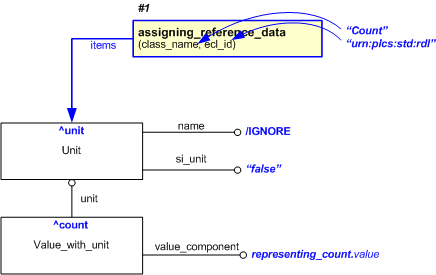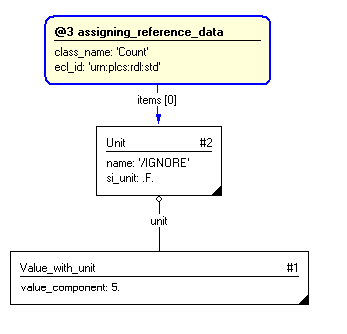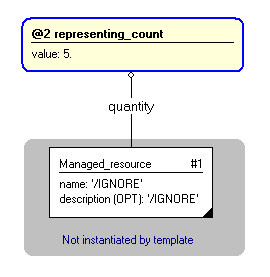| Template:— representing_count (rep_count) |
Date: 2008/01/17 10:56:33
Revision: 1.24
|
This section specifies the template representing_count.
NOTE
An explanation of a template and the associated instantiation path is
provided in the
Template overview
section.
This template describes how to represent a count of items.
EXAMPLE
The number of spark plugs.
The EXPRESS-G diagram in
Figure
1
shows the templates and EXPRESS entities that are required
to represent the template
"representing_count".
The text highlighted in blue shows the template parameters.
Figure 1 — An EXPRESS-G representation of the Information model for representing_count
The graphic for the template to be used in other EXPRESS-G diagrams
is shown in Figure
2
below.
Figure 2 —
The graphical representation of representing_count template
The following input parameters are defined for this template:
The value of the quantity. Default value is 1.
The datatype is always 'any_number_value'
and should not be registered together with the value, i.e. enter the
value as a number, without datatype.
The following reference parameters are defined for this template:
Allow the
Value_with_unit
entity instantiated in this path to be referenced when this template is used.
%^target = $representing_count.count%
Allow the
Unit
entity instantiated in this path to be referenced when this template is used.
Note: The
Unit
entity can be referenced in a template path by:
%^target = $representing_count.unit%
where
target
is the parameter to which the
Unit
is bound.
The following parameter combinations specify a uniqueness constraint:
Unique constraint: Unique Count unit
Each instance of the
entity
(
Unit)
within the data set shall be uniquely identified
by the parameter values set on the following templates instantiated by
representing_count namely:
template #1
assigning_reference_data(
class_name=Count,
ecl_id=urn:plcs:std:rdl).
The
instance is
referenced by the following template parameter:
unit.
The instantiation path shown below specifies the entities that are to be
instantiated by the template.
A description of templates and the syntax for the instantiation path is
provided in the
Templates Help/Information section.
-- Instantiate Value_with_unit entity Value_with_unit-- Set the Value_with_unit attributes Value_with_unit.value_component ->
@value-- Instantiate Unit and point at it Value_with_unit.unit ->
Unit-- Set the Unit attributes Unit.si_unit = 'false'
Unit.name = '/IGNORE'
-- Bind the Value_with_unit to the parameter ^count. -- The parameter is a reference parameter so the Value_with_unit -- entity can be referred to when this template is used. %^count =
Value_with_unit%
-- Bind the Unit to the parameter ^unit. -- The parameter is a reference parameter so the Unitt -- entity can be referred to when this template is used. %^unit =
Unit%
-- Assign reference data for name of Unit /
assigning_reference_data(
items=Unit,
class_name='Count',
ecl_id='urn:plcs:rdl:std')/
The following entities are instantiated with attributes as specified:
The instance diagram in Figure
3
shows an example of the EXPRESS entities and templates that are instantiated by the template:
/representing_count(value='ANY_NUMBER_VALUE(5)')/
(an illustration of the consolidated representing_count template is shown in
Figure
4 below.)
Figure 3 — Entities instantiated by representing_count template
The instance diagram in
Figure
4
shows the graphic symbol for the template that is to be
used in other instance diagrams. The example template is:
/representing_count(value='ANY_NUMBER_VALUE(5)')/
Figure 4 — Instantiation of representing_count template
Characterizations
No common characterizations of the template
representing_count
have been identified. However, the ISO 10303-239 EXPRESS model
may enable other assignments to the entities instantiated by the template.




